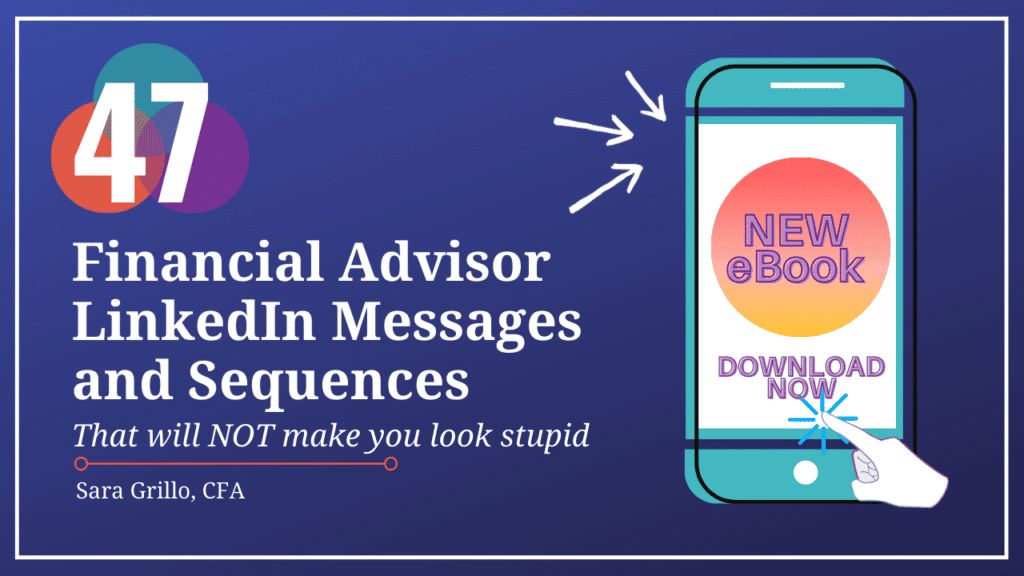Watching financial advisors makes sales mistakes is excruciating. Here are the top sales mistakes that I see financial advisors making, and what to do instead.
#1 Oversharing/foisting the proposal too early
“How do I prevent prospects from taking my proposal and giving it to their brother-in-law who works for Merrill Lynch to implement for them?”
Look, financial advisors.
STOP foisting your hard-earned intellectual property on people before it’s clear what their true intentions are!
Instead of a chance to pitch and make proposals, make the first meeting a time of discernment.
The more equal the level of discernment (equal for both parties – you and the prospect), the higher the chance you will close the business.
Important:
Oversharing is a fatal flaw in disguise. It may seem generous but in reality it 1)imbalances the discernment and hence 2) drives a wedge in between you and the prospect.
Here’s how to balance the degree of sharing between you and the prospect:
For every observation you allow the prospect to make, take an observation of them as well.
Example below.
Prospect: Who do you work with?
You: Most of my clients are 5 to 10 years out of retirement or already retired. Do you fall in either group, or another category?
Prospect: I’m not sure.
You: Ah, I see. Is the confusion over not being sure you can retire, not wanting to retire, or is it something else?
Use the two sentence rule (see this blog) to make the conversation go like a ping-pong match where instead of racing to the proposal, each exchange is an opportunity to build trust.
First sentence is a statement, second statement is a question. Ping, pong, ping, pong…
Emotion goes deeper than fact in the sales process; use discernment to get their emotions right and the proposal will take care of itself.
#2 Chasing around breadcrumbing CPAs
CPAs keep blowing me off and never send me referrals. What do I do?“
Here’s a crazy idea.
Make an effort to understand their business by subscribing to their email newsletter and commenting back to them after you read it.
What if they don’t have an email newsletter?
Teach them how to start one!
In either case you are adding value and showing you aren’t just a slick stock broker with a sales pitch.
Be a giver – don’t just talk about how generous you are. Actually BE generous!
#3 Mishandling DIY investors
“I keep getting these rude do-it-yourself prospects who ask me how to solve a problem they are having, with no intention of hiring me. I feel like telling them to take a hike!”
Whoa…not so fast…
When you tell a DIY prospect to take a hike, you are treating them just as badly as they are treating you.
These attitudes are transactional and wasteful.
Remember that all attention is good attention. Don’t let narrowmindedness cause you to devalue what may become a valuable relationship!
- The DIYer may have friends they could refer you to.
- They may have a business or work somewhere that you could present.
- They may have a CPA or attorney that they could introduce you to.
- They may change at some point if their situation changes, or if your offering changes.
- They could become fervent followers on social media and engage with your content, leading you to higher performance by the LinkedIn algorithm.
The next time somebody asks you for free advice, handle it something like this:
Prospect: Do I take Social Security at 62 or should I wait until 65?
You: From what it sounds like, you need a financial plan with a 15 year retirement income schedule. I wouldn’t be able to answer that properly without going through this exercise and for that you would have to be my client.
If this isn’t the way you want to go, I can refer you to an excellent blog series by a friend of mine which may allow you to figure it out yourself.
What you are doing here is clarifying where the boundary is, which prevents them from walking all over you.
?However, you are still helping them solve their problem which increases the chances of a long term relationship, even if they wind up not hiring you.
You don’t have to abandon your boundaries – keep those boundaries in place – but just make them soft so you don’t push good people away.
Don’t throw people away…it can be so much better than that!
Everyone you meet can be an asset to your business, it’s a matter of how well you motivate them to rise to the occasion.
#4 Not responding to a new lead in a prompt fashion
When a new prospect contact you, respond back to them immediately, in no less than two hours.
The point of initial contact with a new lead should be made immediately. Respond to them within two hours of when they reach out to you.
To be clear: you do not have to set up the meeting right away; but you do have to acknowledge the person right away.
It’s a psychological trait we all have.
We all want to feel taken care of and everyone wants to be responded to immediately. It’s that simple.
Showing them that you take immediate action – no matter what it is – makes a great first impression.
You are not going to believe this.
I called six financial advisors, literally six of them, looking for a new advisor on behalf of a guy who got his portfolio destroyed by a bad advisor. I was shocked when only one (yes, ONE) of the advisors got back to me on the same day.
Moreover, if you have one of them “info@firmname” email addresses on your Contact page, make sure that whoever gets those emails is told to respond immediately when it is a new lead.
If nobody is actively monitoring that email, then why even offer it up? Remove it from your website. I get a response 0.00% of the time when I email someone’s “info@” email address.
Bottom line:
Never do anything, especially in the initial stages of a relationship, that would cause a client to doubt your commitment to them.
Prospects start judging you even before the first meeting. They may not even realize it consciously. The first few hours of a prospect relationship are critical; the clock starts after the minute they contact you.
#5 Letting them breadcrumb you
Question from a subscriber: “This mean prospect wants to give me $150k to start. He says if he is happy with the performance he’ll maybe give me the rest.”
Okeeee.
You have three options here:
- Do what he says, and risk the market going south and you never getting another dime of his money. (high risk)
- Insist that he give you the entire portfolio or else you won’t work with him.(offputting)
- Shift the conversation to factors that are within his and your control, to disciplines where you can truly invoke your highest value as a financial advisor.
The third option wins, right?
Reeeet.
Say a powerful analogy, something like this:
“Marcy, you drive to work everyday, correct?”
“Yes.”
“I’m sure you’d agree it would make less sense to try to predict the weather or traffic jams, and instead make sure the car is in the best possible condition and that we map out the best route.” “Agree.”
“Instead of trying to outperform the market, let’s create a solid retirement income plan and risk tolerance assessment. That way we strive not to meet some arbitrary performance number that may not get you where you need to go, but instead focus on making sure your goals are met.”
Gracefully shift their mindset in a way that spells out the impact your work will have, and why it’s critical to do it this way.
Yeah?
Yah.
BOOM there ya go!
#6 Burning your friends
Question from a subscriber: “I don’t want to mix business with personal, but I have a few friends who would be ideal clients. How do I leverage this, without ruining the relationship?”
Good for you!
(clap emoji)
I’m not the biggest fan of trying to make friends into clients because of the risks involved. Make it clear what you do, but wait for them to show interest (instead of pitching).
Yeah?
Yah.
Take these actions TODAY:
If you do have friends who are ideal clients, here is a wonderful question to ask them:
“As a Delta airlines executive, what would you say is your biggest gap in financial knowledge? Is it something about the 401(k) itself, or is it what to do with the company stock options?”
Genuinely seek to understand how your ideal prospect sees the world – because knowing first hand what is relevant to a particular type of buyer is arguably the most powerful asset you could have in marketing.
Secondly, ask them where they get their financial information from. See if you can tap into that source.
Thirdly, connect with the person on social media and see if you can encourage them to share your updates with their network. Being promoted by someone your targets trust makes you a step up from some random financial advisor.
#7 Not countering objections without pressuring them
Question from a subscriber: “I keep having prospect meetings, but nobody ever wants to become a client. What am I doing wrong?”
Well if anyone needs sales training on countering objections I’d simply invite you to my house at bedtime. See I have four children under 10 years old and every night is the equivalent of a free Dan Sullivan training course.
LoL
But seriously. If you are getting repeatedly rejected in meetings, it is likely a signal that there is an informational misalignment. What you need to do is open the dialogue more so you have vision into the true alignment or lack thereof.
Take these actions TODAY and stop making a huge sales mistake that financial advisors make, overwhelmingly
#1
Before the meeting, ask better questions to get a sense of if this is actually a legit prospect.
Alot of you get your time wasted by Do-It-Yourself people who are just there to get their questions answered and bolt.
Use this questionnaire.
#2
Try to close the business. Don’t use high pressure sales tactics. But get some sense of where you stand.
Say this:
“So, what do you want to do? Do you want to talk again or do you see yourself going in another direction?” (use these words, this is a nice way to help them express a lack of interest)
Then smile and sit in silence until they respond. If you can’t be quiet for 15 seconds, drink water and count to 15 while you are sipping.
#3
If they give you some wishy-washy response like, “I just want to think about it”, you are probably going to lose the deal.
Say this:
“Do you suppose you would kindly be able to offer me a few words of feedback as to your experience so far? This is just for my own professional development.“
Don’t be a high pressure salesperson, just foster an open dialogue because at least you’ll get a clear picture of where you are not in alignment, so you can do better next time.
The best way to open people up is through curiosity. Have a reflective tone and be sincerely interested in how they see things.
#8 Informational misalignment
Question from a subscriber: “I keep having prospect meetings, but nobody ever wants to become a client. What am I doing wrong?”
If you are getting repeatedly rejected in meetings, it is a signal there is an informational misalignment.
Get the information you need by opening the dialogue more so you have vision into the true alignment or lack thereof.
Take these actions TODAY
#1 Ask pre-meeting questions
Before the meeting, ask better questions to get a sense of if this is actually a legit prospect.
Alot of you get your time wasted by Do-It-Yourself people who are just there to get their questions answered and bolt.
Use this questionnaire.
Yeah?
Yaaaaaah.
#2 Try to close the business
I am amazed at how many advisors will leave a meeting without even attempting to gauge the buyer’s level of interest. Don’t use high pressure sales tactics. But get some sense of where you stand.
Say this:
“So, what do you want to do? Do you want to talk again or do you see yourself going in another direction?” (use these words, this is a nice way to help them express a lack of interest)
Then smile and sit in silence until they respond. If you can’t be quiet for 15 seconds, drink water and count to 15 while you are sipping.
#3 Get feedback at the first sign of rejection
If they give you some wishy-washy response like, “I just want to think about it”, recognize that you are probably going to lose the deal.
Respond immediately – don’t just shrug it off without finding out why.
Say this:
“Do you suppose you would kindly be able to offer me a few words of feedback as to your experience so far? This is just for my own professional development.“
Don’t be a high pressure salesperson, just foster an open dialogue because at least you’ll get a clear picture of where you are not in alignment, so you can do better next time.
The best way to open people up is through curiosity. Have a reflective tone and be sincerely interested in how they see things.
Sara’s upshot
In the beginning, the buyer has all the information (and power) and you have none. The information you acquire during the process determines how much the balance shifts.
#9 Bragging
“I’ve been managing money for 30 years and have a depth of knowledge that competition does not. How do I communicate this without sounding like a braggart?“
Wild idea:
How about you let your actions show that you are the best instead of saying it?
Take this action TODAY:
Use your 30 years of knowledge to devise the deepest, most compelling description of the typical portfolio problems clients have. Go way beyond the problems the competition sees.
E.g., “How do I tell the difference between two large cap value mutual funds?”
And then present the deepest, clearest, most compelling explanation of how to solve the problem. Go way beyond the solutions the competition presents. Present this content to the world, and let the chips fall.
Self-centeredness is your worst enemy.
Make it about them, not you, and put their priorities first to the extent that they are unable to think of you as anything but the best person to solve their problem.
#10 Not reading body language
This is called the “Yes to Meh.”
They “yessed” you during the meeting but afterwards it converted to “meh.”
Possible reasons:
- Personal drama (example: house hit by tornado)
- They were never that serious in the first place, but didn’t have the heart to tell you straight up.
- Found somebody else they liked better
- Decided to do it themselves
You can’t do anything about tornados hitting someone’s house; but the others have to do with a lack of ability to find the truth.
Here’s what never lies: body language.
Take these actions TODAY
- Ask prospects if you can record the meeting. Analyzing body language signals can give you a sense of where you are missing non-verbal cues. Watch the video – where did the prospect’s body language show that you should have behaved differently?
- Learn how to detect body language signals that scream, “I’m lying.” Read this blog.
- Make sure you know if they are a legit prospect (see #8 on this list) before you meet
STOP making careless financial advisor sales mistakes!
Alright that’s all for now. I hope this analysis of financial advisor sales mistakes was useful.
Did you sign up for my daily newsletter?
Or if you want more…
Learn what to say to prospects on social media messenger apps without sounding like a washing machine salesperson. This e-book contains 47 financial advisor LinkedIn messages, sequences, and scripts, and they are all two sentences or less.

You could also consider this LinkedIn training program which teaches financial advisors how to get new clients and leads from LinkedIn.

Thanks for reading. See you in the next one!
-Sara G







